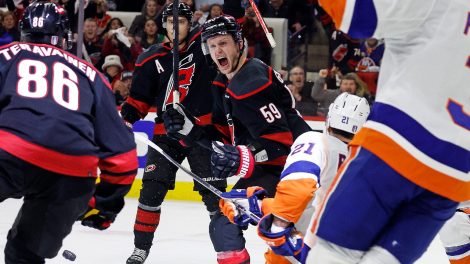Welcome to the bandwagon, Shane Doan.
This week, the Coyotes’ captain made some headlines by suggesting a radical solution to the NHL’s late-season problem of teams tanking and fans rooting for losses.
Many fans will recognize Doan’s suggestion as The Gold Plan that’s been floating around for years. Many more are seeing it for the first time.
The idea goes like this: Instead of a draft lottery system that encourages losing by awarding the best odds to the league’s worst teams, you’d determine the draft order based on the number of points each team earned after being eliminated from the playoffs. Once you’re mathematically out of the playoff hunt, you start the clock on banking points towards your spot in the draft order. The team with the most post-elimination points get the top pick, and so on down through the rest of the non-playoff teams.
The beauty of the plan is that it still weights the odds of getting the first pick heavily towards the league’s worst teams, because they’ll be eliminated first.
In a typical season, the league’s worst teams will get about ten games or so to rack up their points, while teams that come close to the playoffs will only get a couple (and sometimes none at all). We’re still offering a hand up to the teams that need it most. It’s just that now, they have to earn that prize on the ice. And their fans would be able to feel good about wins again.
Doan didn’t invent the concept – the idea became widely known back in 2012 when a then-student named Adam Gold presented it at the Sloan Analytics conference, which is why it’s typically referred to as the Gold Plan and not the Doan Plan.

Others have made similar proposals over the years, and the basic idea has been gaining converts ever since. Who invented what isn’t all that important, since nobody’s stealing anything here. Sometimes, multiple people just happen to come up with a similar idea, especially when it’s a very good one. Which the Gold Plan is.
Sadly, not everyone agrees. Whenever the idea is mentioned, there’s an inevitable pushback, as hockey fans do that hockey fan thing where they try to come up with as many reasons as possible to resist change. And some of those reasons are legitimate. After all, the Gold Plan is clever, but it’s certainly not perfect.
So today, let’s walk through some of the most common objections to the idea – and why you should jump on the bandwagon with Shane Doan and the rest of us anyway.
Point: We don’t need a solution to tanking, because tanking isn’t a problem.
Counterpoint: This is basically the argument raised by Yahoo’s Greg Wyshynski last year. And it’s a fair one – while plenty of fans are turned off by the idea of teams icing less than their best roster as the season wears on, others are just fine with it. The tank has been around for decades, the logic goes, and except for extreme cases (which are rare), it’s hard to distinguish a blatant tank job from the sort of run-of-the-mill rebuild that nobody really objects to.
But tanking is only half the problem that the Gold Plan solves. The other half is that fans are being trained to root for their favourite team to lose. Under the current system, it’s the only rational response. But it never feels right as a fan, and it’s a terrible look for the league.
So even if you want to argue that the Gold Plan is solving a tanking problem that doesn’t exist, it still flips the switch and gets fans cheering for wins again. And it comes with the added bonus of a thrilling stretch run, one that would see all 30 NHL teams fighting for every point available instead of leaving a third of the league to go through the motions with nothing to play for.
That’s an improvement over what we have today, even if you think today is already fine as it is.
Point: Teams will just tank earlier to get eliminated as quickly as possible.
Counterpoint: It’s possible that this is exactly what would happen, at least to some extent. Teams that were out of the race by mid-season might decide to just accelerate the tank, aiming to free fall in January and February instead of March and April.
But how many teams are really out of the race that early? And more importantly, how many GMs are willing to put themselves on the hot seat by throwing in the towel that quickly? Chances are, not many. And the ones that did would have to be especially obvious about what they were doing, which is a good thing. Hey, if we’re going to have teams trying to lose, let’s get it out in the open where we all can see it.
Remember, early tankers wouldn’t have all the tools of the trade available to them, at least not if they were planning to flip the switch and start winning again once they’d been eliminated. A team that dealt away its most productive veterans in January wouldn’t suddenly get them back again in March, so the “tank early and then win late” strategy would be much easier said than done. Teams won’t be able to go scorched earth anymore, because they’ll still need to ice a roster that could win games down the stretch.
But the most important point here isn’t about tanking at all. Even if the worst-case came true and teams just tanked earlier, that doesn’t actually make things any worse than what we have now. We already have widespread taking today; maybe we’d still have it under the Gold Plan, with different timing. But we’d also have an exciting stretch run, one where points mattered and fans were cheering for wins.
Even in the worst-case, that’s still an improvement.
Point: The Gold Plan would kill the trade deadline.
Counterpoint: This is a big one, and it’s tough to deny. By giving even the league’s worst teams a reason to keep winning, you’d remove the incentive for those same teams to sell off everyone with a pulse at the trade deadline. And that would strip a lot of the fun out of one of the days on the hockey calendar that fans look forward to most.
But let’s be honest: The trade deadline is already dead. Or at least, the version of the trade deadline that we all want, with shocking blockbusters and big names flying off the board. That deadline hasn’t existed for years, if it ever did at all. A combination of parity, the salary cap, no-trade clauses and (especially) a league full of timid GMs who’d rather stand pat than risk pulling the trigger to improve has already done that job for us.
But yes, the Gold Plan would probably mean even fewer deals, and that’s a factor worth weighing. If it helps, we’re probably talking about losing the least interesting of those trades. The true blockbusters wouldn’t go anywhere, because no GM of a rebuilding team is going to turn down a first round pick or a can’t-miss prospect just for some vague hope at moving up a spot or two down the stretch. Instead, we’d probably lose the “my third-line rental for your conditional fifth-rounder” type deals that clog up deadline day.
That’s still a loss, but not necessarily a big one.
And maybe, just maybe, a few of those rental deals would be replaced by something that’s almost disappeared from today’s NHL: true hockey trades. If nobody’s in full-fledged fire-sale mode, GMs looking to patch a hole in their roster might be forced to actually make a few old-fashioned player-for-player trades instead of just shipping off mid-round futures.
Or maybe not. But we can dream.
Point: Teams would only have a few games to rack up points, meaning factors like schedule strength and injuries would introduce an element of randomness.
Counterpoint: This one is inarguably true. With only a week or two to work with, any sort of schedule imbalance could tilt the playing field. What if one team is stuck facing a week’s worth of Cup contenders, while another has far easier opponents? Or what if, like this year’s Oilers, a bad team ended up having fewer games to work with because their schedule had been front-loaded and everyone else had games in hand? You could try to account for some of those issues when putting the schedule together, but that only takes you so far. And, of course, one poorly timed injury to a key player could torpedo a team’s chances at the top pick altogether.
So yes, the Gold Plan standings would be determined at least in part by the randomness of the schedule. But do you know what else is random? Lotteries! Determining the draft order based on the whims of bouncing ping pong balls is very, very random. And as you may have heard, that’s pretty much what we do now.
So again, the argument here isn’t that the Gold Plan is perfect, but rather that it would be an improvement over what we have now. If we’re going to let random chance play a role in determining the draft order, let’s at least see it unfold on the ice, instead of in some smoky backroom.
Point: By tying the system to elimination date, you’d risk punishing truly bad teams who happened to be in weak divisions, while helping better teams who were in strong ones.
Counterpoint: Great! That sounds like a feature, not a bug.
The goal of every NHL team is supposed to be winning the Stanley Cup, which means getting into the playoffs as a first step. If a decent team is stuck in a truly overpowered division, we should want to see them get some extra help – they need it. And if a terrible team is lucky enough to be in a division surrounded by other weaklings (we’re all looking at you, Pacific), then they’re already being handed an enormous advantage on their road back to contending.
The whole point behind giving top draft picks to the league’s worst teams is to help those who need it most. A team stuck in a division packed with elite Cup contenders needs help. The Gold Plan would give them a chance to get some.
Point: What about the truly awful team, the one that’s eliminated from the playoffs early but crashes and burns down the stretch, ending up with a mediocre pick despite finishing dead last?
Counterpoint: We’re living in the age of unparalleled competitive balance. The NHL has a hard salary cap, league-wide revenue sharing, and awards points for losing. The system has been rigged to favor parity, with all 30 teams being relentlessly pulled towards the middle at all times.
All of which is to say: If a team playing under these rules is still so terrible that they finished last and can’t even win a game or two down the stretch, they’ve got far bigger problems than the draft order. That’s either the result of blatant tanking or outright incompetence, and in either case, the rest of us shouldn’t feel obligated to reward them with a franchise player for their trouble.
Point: This Gold Plan isn’t a bad concept, but I have a slightly different idea that I’d like to tell you about…
Counterpoint: Fixing the draft system is a topic that always generates plenty of discussion, and it’s possible that even if you like the Gold Plan, it’s not your favourite alternative. Maybe you’d prefer the variation where every non-playoff team starts banking points at the same time (just remember, that no longer gives the league’s worst teams any kind of head start). Maybe you’d rather have a lottery with flat odds, where each team gets one ping pong ball and that’s the end of it. Maybe you’d rather see a more radical solution, the The Wheel or a mini-tournament. Or maybe you even want to scrap the draft altogether and be done with it.
Everyone is entitled to make their own case for whatever they think would be best. Just remember that if you insist that your favourite idea is the one and only option worth considering, you’re voting for the status quo. Nothing changes as long as we’re all busy arguing for our personal preference.
This is kind of a running problem in hockey circles. It’s why we’re still stuck with a loser point that everyone agrees is “the stupidest rule in sports“; because the bring-back-ties brigade can’t get on the same page with the three-point-games coalition who can’t work with the just-count-the-wins crowd. It’s why the league has spent two decades failing to fix the scoring issue; we get caught up debating minor tweaks to faceoff rules and shifting the blue lines in and out by a few inches because everything else is subjected to too much of a fight to ever get any traction.
If you think the current draft system is working, then stick with it. But if you think it’s broken, then find a better option and get behind it, even if it’s not your platonic ideal.
Point: I’m an Edmonton Oilers fan and actually I think the current system is already perfect, thanks.
Counterpoint: Uh… yeah. Can’t really argue with this one.
But just for the record: Guess who would have ended up winning the Connor McDavid Cup if the system had been in place last year? You guessed it. Wouldn’t that have been more fun than relying on ping pong balls, Oilers fans? And as an added bonus, the other 29 fan bases wouldn’t even have been able to whine incessantly about it, because you’d have earned it.
You’re nodding right now, aren’t you, Oilers fans? I knew it. Welcome aboard the Gold Plan bandwagon. It’s filling up quickly, but you can still grab a seat over there next to Shane Doan.









